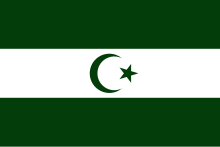Rutul people
This article needs additional citations for verification. (January 2010) |
| |
|---|---|
 Flag of the Rutul Nationalist movement[1] | |
| Total population | |
| c. 120,000[2] | |
| Regions with significant populations | |
| 34,259 (2021)[3] | |
| 17,000 (~2000) - 40,000[2][4] | |
| 137 (2001)[5] | |
| 103 (1989)[6] | |
| Languages | |
| Rutul, Russian, Azerbaijani | |
| Religion | |
| Sunni Islam | |
| Related ethnic groups | |
| Other Northeast Caucasian-speaking peoples Especially Tsakhurs | |
Rutulians,[7] Rutuls (Rutul: Мыхабыр, romanized: Mykhabyr), also known as the Rutul people are a Northeast Caucasian ethnic group native to Dagestan and adjacent parts of Azerbaijan. According to the 2021 Russian census, there were 34,259 Rutuls in Russia.[3] The Rutul language is a member of the Northeast Caucasian language family; its speakers often have a good command of Azeri and Russian, as Rutul was not a written language until 1990. The Rutul culture is close to that of the Tsakhur and other peoples who inhabit the basin of the upper reaches of the Samur River. Most of the Rutuls are engaged in cattle breeding (mostly sheep husbandry), farming, and gardening.
Geography
[edit]Most of the Rutulians live in the Rutulsky District of Dagestan. According to the 2010 census, 35,240 Rutulians lived in Russia.
Rutulian villages in Russia: Rutul, Luchek, Ikhrek, Myukhrek, Amsar, Kina, Vrush, Jilikhur, Kala, Pilek, Shinaz, Khnyukh, Natsma, Fartma, Kufa, Fuchukh, Kiche, Una, Tsudik, Aran, Rybalko, Borch, New Borch, Khnov, Chude
Rutulian villages and cities in Azerbaijan: Sheki (Nukha), Shin, Shorsu, Goybulaq, Kish, Dashyuz, Aydinbulakh, Baltali, Incha, Kudurlu, Boyuk Dahna, Khirsa
Religion
[edit]The Rutuls adhere to Sunni Islam. The earliest attempts of Arabs to affirm as Dagestan concern the 7th century, and in Rutul's territory they made the greatest success. The earliest monument of Muslim culture testifies to it on caucasus - a tombstone of Sheikh Magomeda-ibn-Asada-ibn-Mugal, buried in Khnov in 675 AD[8] About early Islamisation of Rutuls the earliest testify also in mountains of Dagestan monuments building epigraphic, found in some Rutul villages. It is a stone in a wall of a building of a mosque of settlement village Luchek on which the chronograph text in the Arabian language is cut, Islam carrying the statement here to 128 of Hijra, that is 745–746. Other stone with the chronograph text has remained in a settlement Ikhrek mosque of Ikhrek, in it is spoken «about restoration of the destroyed mosque in 407 of Hijra»
Economics
[edit]The inhabitants led a sedentary lifestyle, engaged in horse breeding, transhumance sheep breeding, weapons manufacturing, blacksmithing, ceramics and hunting.[9]
Notable Rutuls
[edit]- Gasret Aliev- a Hero of Soviet Union, 1st secretary of the Communist Party of the Soviet Union in Rutul from 1957 to 1961
- Ulfat Idlibi - writer
- İbrahim Şinasi - founder of Turkish dramaturgy
- Saniyat Ganachueva - first Russian world champion in women's freestyle wrestling
- Vadim Musaev - professional boxer
- Ismayil Daghistanli - Azerbaijani and Soviet stage and film actor and pedagogue
- Seyfula Magomedov - taekwondo practitioner, the first ever 4-time European Taekwondo Champion
See also
[edit]Notes
[edit]- ^ "ЛИРА - Руту́льцы". lezgi-kabir.ucoz.ru. Retrieved 2024-07-14.
- ^ a b "Rutuls". rutulia.com. Archived from the original on January 15, 2018.
- ^ a b "Национальный состав населения Российской Федерации согласно переписи населения 2021 года" (in Russian). Archived from the original on 2022-12-30. Retrieved 2023-01-05.
- ^ Rutuls in Azerbayjan
- ^ &n_page=4 State statistics committee of Ukraine - National composition of population, 2001 census (Ukrainian)
- ^ Перепись в Грузии 1989 года - Census in Georgia, 1989
- ^ Yurkov, Y.A.; Sokolin, V.L. (1998). Population of Russia: 1897-1997. Statistical Abstract (PDF). State Committee of the Russian Federation on Statistics (Goskomstat of Russia), 105679, Moscow, Izmailovskoye highway, 44; JSC "Moscow Publishing House"; PPO "Izvestiya" 103798, Moscow, Pushkinskaya Square, 5. p. 213. ISBN 5-89476-014-3. Archived from the original (PDF) on 2018-10-24. Retrieved 2015-11-25.
- ^ Vuchetich N. G.: "Chetyre mesyatsa v Dagestane" (Four months in Dagestan), "Caucasus" No.72 Tiflis, 1864.
- ^ "Советская этнография", Publisher: Изд-во Академии наук, 1953, page 31
External links
[edit]- Folk Songs and Dances of the Rutuls of Azerbaijan
- rutulia.com — Rutul national website.

